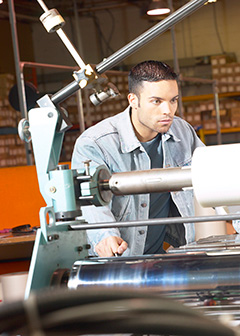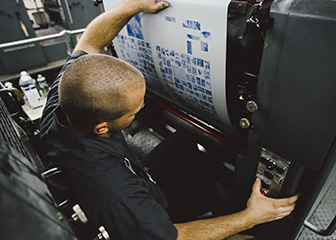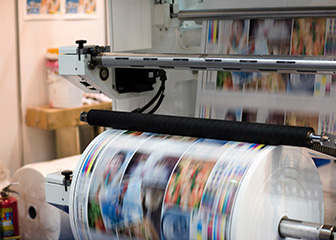
Printing press operators prepare, operate, and maintain printing presses.
Printing workers produce print material in three stages: prepress, press, and binding and finishing. They review specifications, identify and fix problems with printing equipment, and assemble pages.
Duties
Printing workers typically do the following:
- Arrange pages so that materials can be printed
- Operate laser plate-making equipment that converts electronic data to plates
- Review job orders to determine quantities to be printed, paper specifications, colors, and special printing instructions
- Feed paper through press cylinders and adjust equipment controls
- Collect and inspect random samples during print runs to identify any needed adjustments
- Bind new books, using hand tools such as bone folders, knives, hammers, or brass binding tools
- Cut material to specified dimensions, fitting and gluing material to binder boards by hand or machine
- Compress sewed or glued sets of pages, called "signatures," using hand presses or smashing machines
The printing process has three stages: prepress, press, and binding or finishing. In small print shops, the same person may take care of all three stages. However, in most print shops, the following workers specialize in one of the three stages:
Prepress technicians and workers prepare print jobs. They do a variety of tasks to help turn text and pictures into finished pages and prepare the pages for print. Some prepress technicians, known as “preflight technicians,” take images from graphic designers or customers and check them for completeness. They review job specifications and designs from submitted sketches or clients’ electronic files to ensure that everything is correct and all files and photos are included.
Some prepress workers use a photographic process to make offset printing plates (sheets of metal that carry the final image to be printed). This is a complex process involving ultraviolet light and chemical exposure through which the text and images of a print job harden on a metal plate and become water repellent. These hard, water-repellent portions of the metal plate are in the form of the text and images that will be printed.
More recently, however, the printing industry has moved to technology known as “direct-to-plate.” Many prepress technicians now send the data directly to a plating system, bypassing the need for the photographic technique. The direct-to-plate technique is an example of how digital imaging technology has largely replaced cold-type print technology.
Printing press operators prepare, run, and maintain printing presses. Their duties vary according to the type of press they operate. Traditional printing methods, such as offset lithography, gravure, flexography, and letterpress, use a plate or roller that carries the final image that is to be printed and then copies the image to paper.
In addition to the traditional printing processes, plateless or nonimpact processes are becoming more common. Plateless processes—including digital, electrostatic, and ink-jet printing—are used for copying, duplicating, and document and specialty printing, usually in quick-printing shops and smaller printing shops.
Commercial printers are increasingly using digital presses with longer-run capabilities for short-run or customized printing jobs. Digital presses also allow printers to transfer files, blend colors, and proof images electronically, thus avoiding the costly and time-consuming steps of making printing plates that are common in offset printing.
Print binding and finishing workers combine printed sheets into a finished product, such as a book, magazine, or catalog. Their duties depend on what they are binding. Some types of binding and finishing jobs take only one step. Preparing leaflets or newspaper inserts, for example, requires only folding and trimming.
Binding books and magazines, however, takes several steps. Bindery workers first assemble the books and magazines from large, flat, printed sheets of paper. They then operate machines that fold printed sheets into “signatures,” which are groups of pages arranged sequentially. They assemble the signatures in the right order and join them by saddle stitching (stapling them through the middle of the binding) or perfect binding (using glue, not stitches or staples).
Some bookbinders repair rare books by sewing, stitching, or gluing the covers or the pages.








